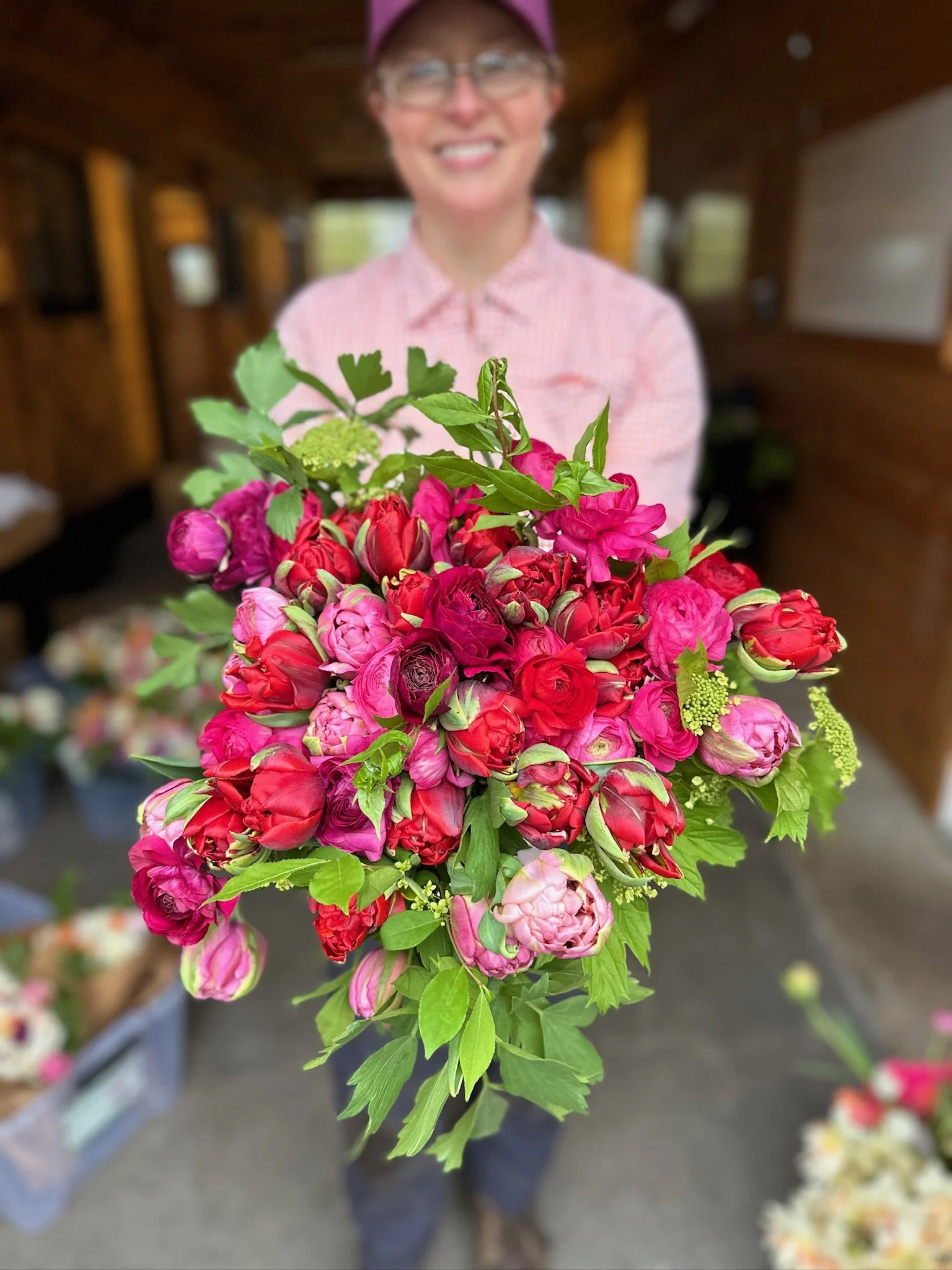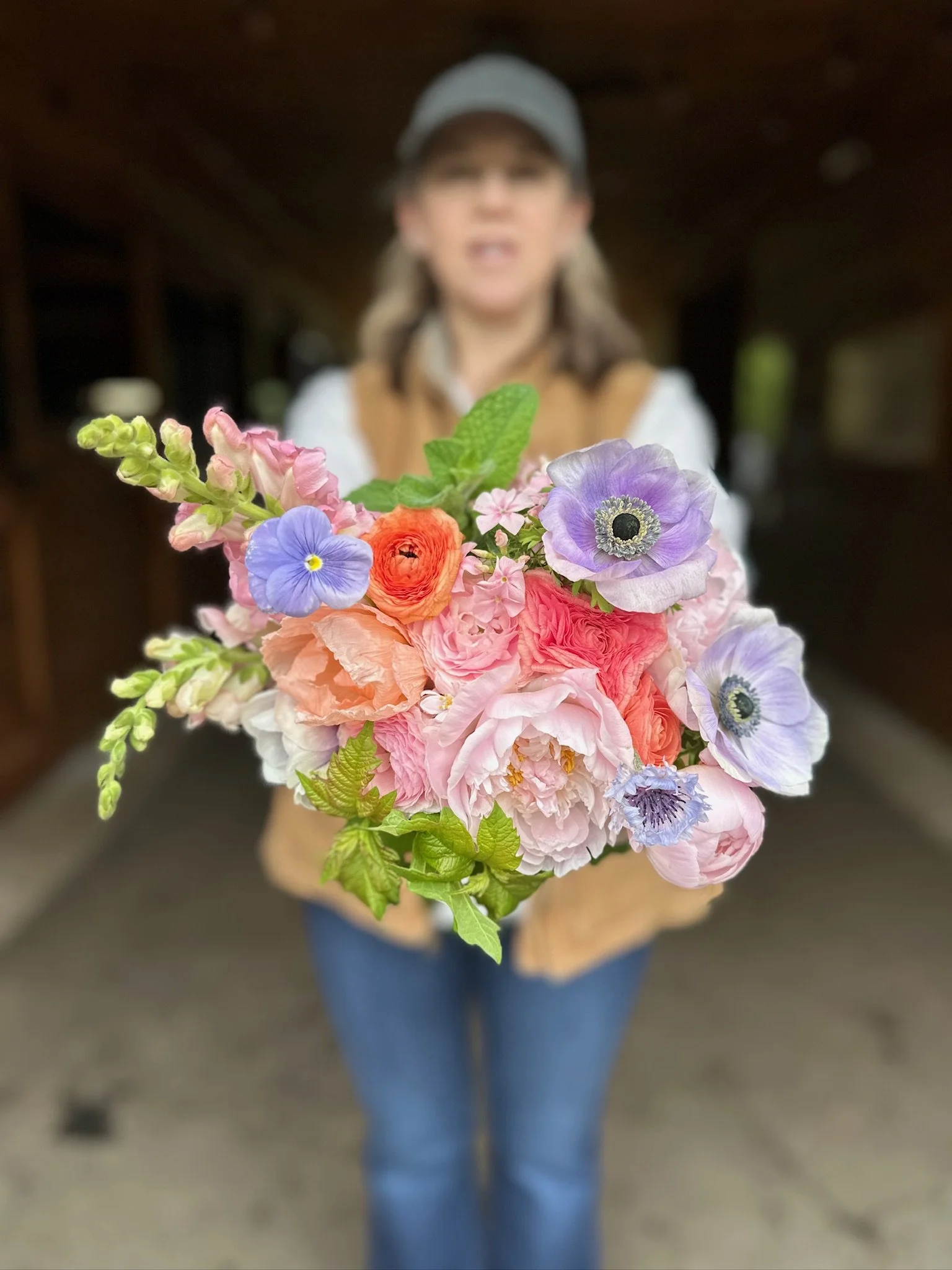Stop Overstuffing Your Bouquets (and Start Saving Your Business)
Confidence has never been one of my strong suits. When I was a kid, I was the shy one who rarely raised her hand in class, even when I knew the answer. That same hesitation followed me into my corporate career—and eventually, into flower farming. So when I started selling bouquets at farmers markets, it wasn’t surprising that I doubted whether my flowers (or my designs) were “good enough.”
My answer to that fear? I crammed in more stems. Every time. If I worried that customers wouldn’t think a bouquet was worth the price, I’d add another ranunculus (or two), another lisianthus, another dahlia. It felt like I was creating an insurance policy against coming home with unsold bouquets.
But here’s the truth: I wasn’t adding security—I was bleeding my business dry. I knew, deep down, that my per-stem price was unsustainable. In fact, in my early markets, I sometimes sold bouquets for less per stem than I could have earned wholesaling those same flowers. But fear is a powerful emotion.
Over the years, customers sometimes reinforced that fear. I remember a few who said things like, “I can grow those myself for less.” Those words stung at first. But as I gained more experience—and more confidence—I came to see that customers weren’t just paying for the flowers. They were paying for the color palettes I’d curated, the blooms that they could never grow themselves, and the designs that dropped into a vase looking effortlessly stunning. Once I recognized the real value I offered, I stopped feeling the need to overcompensate with extra stems.
The Overstuffing Trap
In those early days, making market bouquets was a bit like baking without a recipe—and our “solution” for any doubt about beauty or value was always the same: add more flowers. As bouquet-making went later into the night, our bouquet sizes crept up until we were making what we jokingly called “two-fisters”—bouquets so big you couldn’t even hold them in one hand.
Part of it was fear, but part of it was faulty logic. I told myself I would “hook” customers with these big, beautiful bouquets and then later, once they were loyal, I could adjust the bouquet sizes and charge what they were actually worth. And to be fair, it kind of worked—we did have plenty of customers who stuck with us as we “right-sized” our bouquets over the years. But I see now that it would have been far better to stop overstuffing from the start. All I did was set an unrealistic standard that took years to undo.
Overstuffing might feel like the “safe” choice, but it’s anything but safe. Every extra stem eats into your margins. If your pricing isn’t sustainable when you’re small, overstuffing means that when you grow—when you’re making dozens or hundreds of bouquets—you’ll just lose money faster.
A couple of bouquets from the early days, when we were still overstuffing. These early spring bouquets are HUGE (and hugely overstuffed, compared to what we charged for them) and will explode into triple this size once the flowers open. They were made without following the Bouquet Blueprint™ framework, which helps alleviate overstuffing—because when you have the right mix of flower types, a bouquet looks beautiful even without all of the extra stems.
The Economics of Overstuffing
Here’s the cold, hard truth: every stem you add to a bouquet has a cost—seeds or plugs, compost, fertilizer, watering, weeding, and the labor to cut, strip, store and arrange it. When you cram extra stems into a bouquet, you’re not just “using up extras.” You’re eroding your profit margin with every handful.
Take a simple example: Imagine a $25 market bouquet. You plan for 20 stems, so each stem is worth $1.25 in that bouquet. But if you panic and toss in 5 more stems, that same $25 bouquet now gives each stem a value of just $1.00.
Multiply that by 20, 40, or 100 bouquets on a busy market day, and you can see how quickly this “generosity” turns from a financial leak to a firehose of lost profits. If your pricing and recipes aren’t sustainable when you’re making 10 bouquets, they’ll sink your business when you’re making 100.
Customer Confusion & Price Perception
There’s another hidden cost to overstuffing: customer confusion.
If you start out with overly generous bouquets and then, later, you reduce their size to get to a sustainable level, customers will notice. They’ll think they’re paying the same price for less—because they are. It doesn’t matter that your original pricing was flawed; you’ve trained them to expect an unrealistic deal.
We never really had customers call out changes in our bouquet sizes or pricing. Though some may have quietly stopped buying from us, our steady stream of new customers closed that gap. Honestly, the people I had the toughest time convincing weren’t customers—they were my own team. I think they were concerned they’d get pushback at the farmers market, so we spent time discussing how to confidently answer questions about pricing. We talked about all the things that make our bouquets different—highlighting the unusual flower varieties, harmonious palettes, and vase-ready designs that made our bouquets stand apart, and also the benefits of supporting local agriculture.
We also discussed the bigger picture, as a team—though we don’t push these issues with customers, so as not to sound defensive. For example, we don’t pay minimum wage or rely on lower-cost visa workers; instead, we employ people from our local community, which is an expensive place to live. We also make choices that protect the environment and preserve farmland, which comes with higher labor costs: no pesticides, and weeds removed almost exclusively by hand. Those conversations weren’t really about crafting “scripts” for customers; they were about helping my team see why we needed to charge prices that would sustain the farm—and all of us who work here—over the long term.
Today, when customers occasionally compare our bouquets to a vegetable farmer’s $10 sunflower-and-zinnia bundle, I know the value we bring is completely different. Those farmers often treat flowers as a loss leader—a product that is intentionally priced below cost in order to attract customers in, so they will buy other products with positive profit margins. We, on the other hand, stay focused on creating something that our customers value enough to pay for. In fact, we’ve had people come up to our booth at the farmers market with another farmer’s flowers in hand and say, “If I’d seen your flowers first, I would have bought from you instead—these are amazing!”
Community Impact
Overstuffing doesn’t just hurt your bottom line—it can hurt the entire local flower farming community. When you underprice or overstuff to make a sale, you set a false expectation in the market. Other farmers who are pricing correctly suddenly look “expensive,” even though they’re the ones building sustainable businesses.
To be clear, I’m not suggesting that flower farmers collaborate to set prices—that’s not how this works (and it’s illegal). If you’re able to grow flowers at a cost that justifies lower pricing, that’s great! But the truth is, most beginner farmers make one of two mistakes:
Not accounting for all of their costs—especially their own labor, which they often treat as “free.”
Overstuffing due to lack of confidence, which we’ve already discussed.
If the community argument isn’t enough to sway you, consider this: if you don’t factor your own labor into your prices, you’ll never be able to scale up your business. You can’t hire someone else to do the work for free, and so building sustainable prices from the start is the only way to grow without burning out or going broke. You’re not just setting prices for today—you’re setting a foundation for growth.
By sticking to fair pricing and right-sized bouquets, you’re helping set the standard for valuing local flowers properly. When customers see consistent pricing—not necessarily identical, but consistent—across multiple vendors, they begin to understand what goes into quality, locally grown flowers.
These bouquets were all created using the Bouquet Blueprint™, which keeps size and value consistent from bouquet to bouquet and from season to season. Spring bouquets present a special challenge because flowers like ranunculus, anemones and tulips are kept in tight bud to provide optimal vase life, which can make the bouquet look smaller at the time of sale. Customer education helps—we often bring a bouquet of fully opened flowers to the farmers market, so that customers can see what the product will look like once all the flowers open. We also take the time to create bouquets with blown open flowers—like these—so that we have pictures of what customers are really getting when they purchase one of our bouquets.
The Fix: Design With Intent
The solution isn’t to make skimpy bouquets. It’s to make intentional bouquets that look lush and abundant—without sabotaging your profit margins.
That’s where the Bouquet Blueprint™ comes in. This framework helped us move away from “winging it” to creating bouquets that are balanced, efficient, and gorgeous.
Using the spiral technique when building your bouquets also helps. It provides separation between the flowers and gives the bouquet natural fullness and shape, and it also reduces damage to the flowers and speeds up production—win-win.
If you’re overstuffing your bouquets, you’re not being generous—you’re quietly draining your business. You don’t have to choose between beauty and profitability. With the right tools and approach, you can create bouquets that wow customers, build loyalty, and sustain your farm for the long haul.
The Bouquet Blueprint™ Workbook
✔️ Make irresistible bouquets that sell
✔️ Use reliable recipes that protect your pricing
✔️ Design with confidence and ease, putting every floral ingredients in it’s rightful place within the bouquet
🌸 50+ page guidebook with 8 tools and templates INCLUDED!







